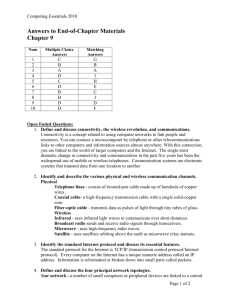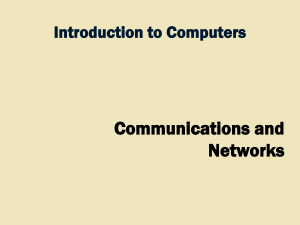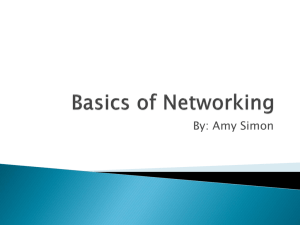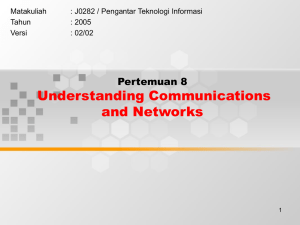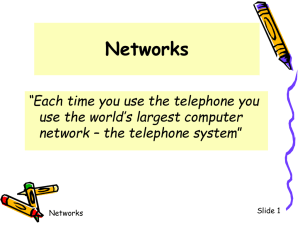Chapter 8
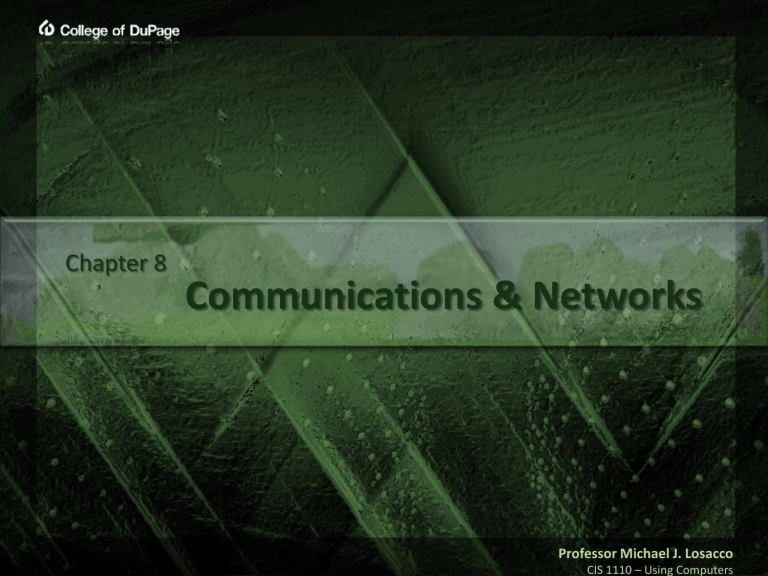
Chapter 8
Communications & Networks
Professor Michael J. Losacco
CIS 1110 – Using Computers
Chapter
8
Overview
Identify Various Communication Uses
List Network Advantages
Differentiate Network Types
Describe Communications Standards
Describe Communications Devices
Identify Different Transmission Media
2/26
Chapter
8
Communications
Two or More Devices
Transfer Data or Instructions
Requirements
Sending Device
Communications Device
Connects Sending Device to Channel
Connects Channel to Receiving Device
Communications Channel
Media on Which Data Travels
Receiving Device
3/26
Chapter
8
Uses
Wireless Messaging
Text Messaging
Send / Receive Text Messages Using Phone
14-17: 60 v. 5
Picture Messaging
Pew Internet 5/10
Send / Receive Graphics, Pictures, Video
Sexting: 30% of 17-year-olds
Pew Internet 12/09
4/26
Chapter
8
Uses
GPS (Global Positioning System)
Signals Sent by Satellites Orbiting Earth
Signal Sent Every 1/1000 of a Second
Earth-based Receivers Analyze Signals
Determine Receiver’s Geographic Location
Groupware
Assists Groups in Working Together
Share Data Over Network e.g., Schedule Meetings
5/26
Chapter
8
Uses
Web Services
Software Applications
Communicate with Other Remote Computers
Use Internet or Internal Business Network
Mashup
Combines Services from Multiple Sources
6/26
Chapter
8
Uses
Very Hard to Give Up
75%
50%
38%
51%
38%
45% 47% 43%
63%
40%
25%
0%
Cell Phone Internet TV
36%
6%
Phone Wireless
2002 2007
Pew Internet 3/08
7/26
Chapter
8
Networks
Collection of Computers & Devices
Connected via
Communications Devices
Transmission Media
Advantages
Facilitating Communications
Sharing Hardware
Sharing Software
Sharing Data And Information
8/26
Chapter
8
Network Types
LAN (Local Area Network)
Network in Limited Geographical Area
Typically Within a Building
WLAN
Wireless LAN
WAN (Wide Area Network)
Large Geographic Area
Uses Many Types of Media
Internet
9/26
Chapter
8
Network Architectures
Client/Server
Client
Requests Resource Accessed from Server
Server
One or More Computers Controlling Resource
P2P (Peer-to-Peer)
Access Any Other Computer in Network
Internet File Sharing
10/26
Chapter
8
Network Topology
Configuration of Devices in a Network
Bus
Consists of Single Central Cable
All Devices Connect to it
Inexpensive & Easy to Install
11/26
Chapter
8
Network Topology
Ring
Cable Forms Closed Ring
Data Travels In One Direction
Expensive & Difficult to Install
Star
All Devices Connect to Hub
All Data Passes Through Hub
Bottlenecks Can Occur
Easy to Install
12/26
Chapter
8
Intranet & Extranet
Intranet
Internal Corporate Network
Uses Internet
Accessible to Corporate Employees
Facilitates Working in Groups
Extranet
Allows Access to Parts of a Intranet
Customers / Suppliers
13/26
Chapter
8
Protocol
Protocol
Collection of Procedures
Establish, Maintain, & Terminate Transmissions
Type of Error Checking Used
Data Compression Method, If Any
Indicate Finished Sending Message
Indicate Message Has Been Received
14/26
Chapter
8
Standards
Ethernet
For LANs
Uses Bus or Star Topology
Widely Implemented
TCP/IP
Used for Internet Transmissions
Packet Switching
Transmits Data by Breaking it Into Packets
Reassembles Data at Destination
15/26
Chapter
8
Standards
802.11 (Wi-Fi)
Family of Standards for Wireless LANs
802.16 (WiMAX)
Towers Cover 30-mile Radius
Provides Wireless Broadband Internet
Bluetooth
Short-range Radio Technology
WAP
Wireless Mobile Devices Connect to Internet
16/26
Chapter
8
Standards
IrDA
Data Transferred via Infrared Light Waves
RFID
Radio Signals Communicate with Tags
Failed Legislation
Nevada
Require Retailers to Inform Customers
Rhode Island
Government Agency Cannot Track Individuals
Texas
Prohibit Schools from Using RFID on Students
17/26
Chapter
8
Types & Speeds
Measured in bps (Bits per Second)
18/26
Chapter
8
Devices
Modem
Converts Analog to Digital & Vice Versa
Required for Telephone Line Communication
DSL Modem
Cable Modem
Uses Cable TV Network
19/26
Chapter
8
Devices
Wireless Modem
Internet Access
Network Card
Connects PC to Network
Wireless Access Point
20/26
Chapter
8
Devices
Router
Connects Multiple Computers / Routers
Transmits Data to Network Destination
Uses Fastest Available Path
Many Protected by Hardware Firewall
Hub / Switch
Provides Central Point for Network Cables
21/26
Chapter
8
Channel
Communication Path Between Devices
Bandwidth
Difference Between Frequencies
Amount of Data that Travel Over Channel
Latency
Time for Signal to Travel
From One Network Location to Another
22/26
Chapter
8
Broadband
Channel
Transmit Multiple Signals over Channel
Transmission Media
Materials or Techniques
Capable of Carrying Signals
23/26
Chapter
8
Physical Transmission Media
Twisted-pair
Telephone System
Coaxial Cable
Cable Television
Fiber-optic
Thin Strands of Glass or Plastic
Uses Light to Transmit Signals
Less Susceptible to Interference
More Secure
24/26
Chapter
8
Wireless Transmission Media
Broadcast Radio
Distributes Radio Signals
Long & Short Distances
Cellular Radio
Widely Used for Mobile Communications
25/26
Chapter
8
Wireless Transmission Media
Microwave Station
Earth-based Reflective Dish
Contains Antenna, Transceivers
Uses Line-of-sight Transmission
Satellite
Space Station
Receives Microwave Signals
Amplifies Signals
Broadcasts Signals Back
26/26
